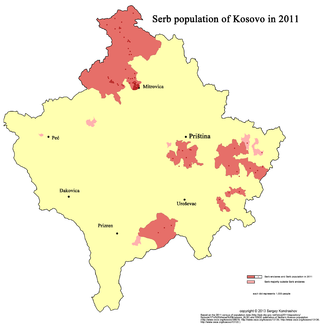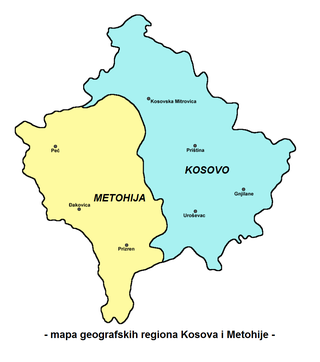See also
- Metohiya, a village in Treklyano Municipality, Bulgaria
- Kosovo (disambiguation)
- Kosovo and Metohija (disambiguation)
Metohija is a region in the southwestern part of Kosovo.
Metohija may also refer to:
Kosovo, officially the Republic of Kosovo, is a partially-recognized state in Europe.

Serbian enclaves are settlements in Kosovo outside North Kosovo where Serbs form a majority. After the initial outflow after the Kosovo War the situation of the Kosovo Serb communities has improved and under the Ahtisaari plan minority rights have been promoted.
Kim or KIM may refer to:

Metohija or Dukagjin is a large basin and the name of the region covering the southwestern part of Kosovo. The region covers 35% (3,891 km2) of Kosovo's total area. According to the 2011 census, the population of the region is 700,577.

An administrative district of Serbia is the country's first-level administrative division. The term okrug means "circuit" and corresponds to Bezirk in German language. It can be translated as "county", though it is generally rendered by the Serbian government as "district". Prior to a 2006 decree, the administrative districts were named simply districts.

Podujevo or Besianë is a city and municipality in Pristina District in Kosovo. According to the 2011 census, the city of Podujevo has 23,453 inhabitants, while the municipality has 88,499 inhabitants. Podujevo is the largest municipality of Kosovo since it covers 633 km2 (244 sq mi) and is located along a regional motorway and also has railroad passing through it, which links the area to surrounding regions. Pristina, the capital of Kosovo, is located some 23 km (14 mi) to the south.
The politics of Kosovo takes place in a framework of a multi-party parliamentary representative democratic republic, whereby the President (Presidenti) is the head of state and the Prime Minister (Kryeministri) the head of government. Parliamentary elections are held every four years, the most recent in 2021.
The administrative divisions of Serbia are regulated by the Government of Serbia Enactment of 29 January 1992, and by the Law on Territorial Organization adopted by the National Assembly of Serbia on 29 December 2007.

Leposavić also known as Leposaviq or Albanik, is a town and the northernmost municipality in the Mitrovica District in Kosovo. As of 2015, it has an estimated population of 18,600 inhabitants. The municipality covers an area of 539 km2 (208 sq mi) which makes it the fifth largest in Kosovo, and consists of the town and 72 villages.

The municipalities and cities are the second level administrative subdivisions of Serbia. The country is divided into 145 municipalities and 29 cities, forming the basic level of local government.

The Socialist Republic of Serbia, previously known as the People's Republic of Serbia, was one of the six constituent republics of the Socialist Federal Republic of Yugoslavia in what is now the modern day states of Serbia and the disputed territory of Kosovo. Its formation was initiated in 1941, and achieved in 1944–1946, when it was established as a federated republic within Yugoslavia. In that form, it lasted until the constitutional reforms from 1990 to 1992, when it was reconstituted, as the Republic of Serbia within the Federal Republic of Yugoslavia. It was the largest constituent republic of Yugoslavia, in terms of population and territory. Its capital, Belgrade, was also the federal capital of Yugoslavia.
The political status of Kosovo, also known as the Kosovo question, is the subject of a long-running political and territorial dispute between the Serbian government and the Government of Kosovo, stemming from the breakup of Yugoslavia (1991–92) and the ensuing Kosovo War (1998–99). In 1999, the administration of the Autonomous Province of Kosovo and Metohija was handed on an interim basis to the United Nations under the terms of UNSCR 1244 which ended the Kosovo conflict of that year. That resolution reaffirmed the territorial integrity of Serbia over Kosovo but required the UN administration to promote the establishment of 'substantial autonomy and self-government' for Kosovo pending a 'final settlement' for negotiation between the parties.

The current Constitution of the Republic of Serbia, also known as Mitrovdan Constitution was adopted in 2006, replacing the previous constitution dating from 1990. The adoption of new constitution became necessary in 2006 when Serbia became independent after Montenegro's secession and the dissolution of Serbia and Montenegro.

The Autonomous Province of Kosovo and Metohija, commonly known as Kosovo and abbreviated to Kosmet or KiM, is an autonomous province defined by the Constitution of Serbia that occupies the southernmost part of Serbia. The territory is the subject of an ongoing political and territorial dispute between Republic of Serbia and the partially recognised Republic of Kosovo, the latter of which has control over the territory. Its claimed administrative capital and largest city is Pristina.
Podgorac may refer to:

The Assembly of the Community of Municipalities of the Autonomous Province of Kosovo and Metohija, was the assembly of the association of local governments created by the municipal authorities in Kosovo elected in the May 11, 2008 municipal elections called by the Government of Serbia. It was created in Kosovska Mitrovica to represent the municipalities that defy the 2008 Kosovo declaration of independence. The Assembly was composed of 45 representatives delegated by 26 municipalities. The majority of delegates were ethnic Serbs, while some represented Gorani, Bosniak and Romani communities.
An advisory referendum on accepting the institutions of the Republic of Kosovo was held in the Serb-dominated regions of North Kosovo on 14 and 15 February 2012. The referendum was held in Zubin Potok, Zvečan and Mitrovica on both days, while Leposavić voted on 15 February. The voting ran from 7:00 to 19:00 on both days. The result saw 99.74% of voters reject the writ of the Republic of Kosovo's institutions. The poll was rejected by the governments of both Serbia and Kosovo.

Serbian National Council of Kosovo and Metohija is an elected political and coordinating body acting as a representative of Serbs of Kosovo.

The Socialist Autonomous Province of Kosovo, referred to as simply Kosovo, was one of the two autonomous provinces of the Socialist Republic of Serbia within Yugoslavia, between 1945 and 1990, when it was renamed Autonomous Province of Kosovo and Metohija.

United Nations Administered Kosovo refers to the period between 1999 and 2008 when the United Nations Interim Administration Mission in Kosovo was directly responsible for the governance of Kosovo. This period began on 10 June 1999 with the passing of United Nations Security Council Resolution 1244 and effectively ended on 17 February 2008 with the unilateral declaration of independence of Kosovo.